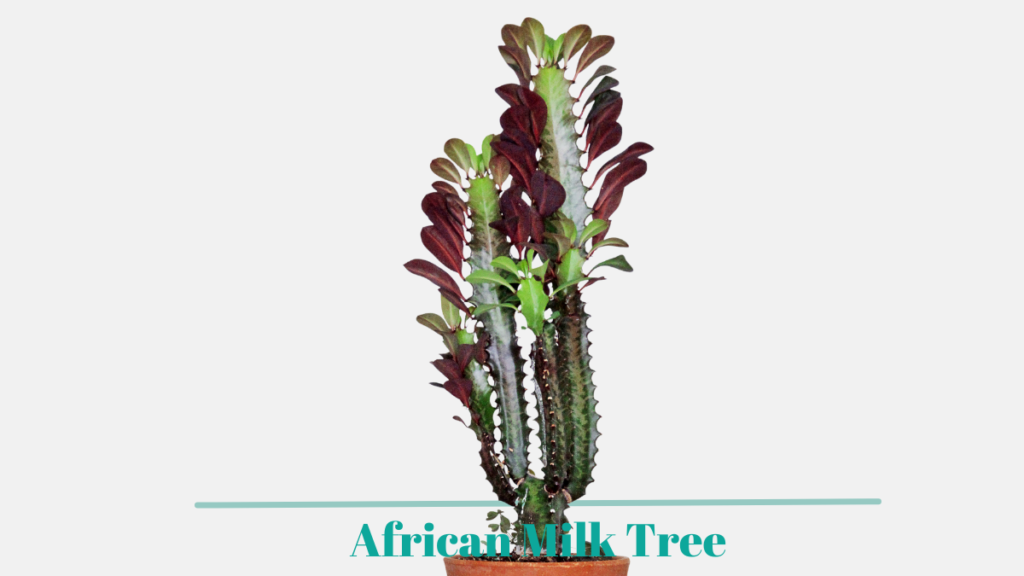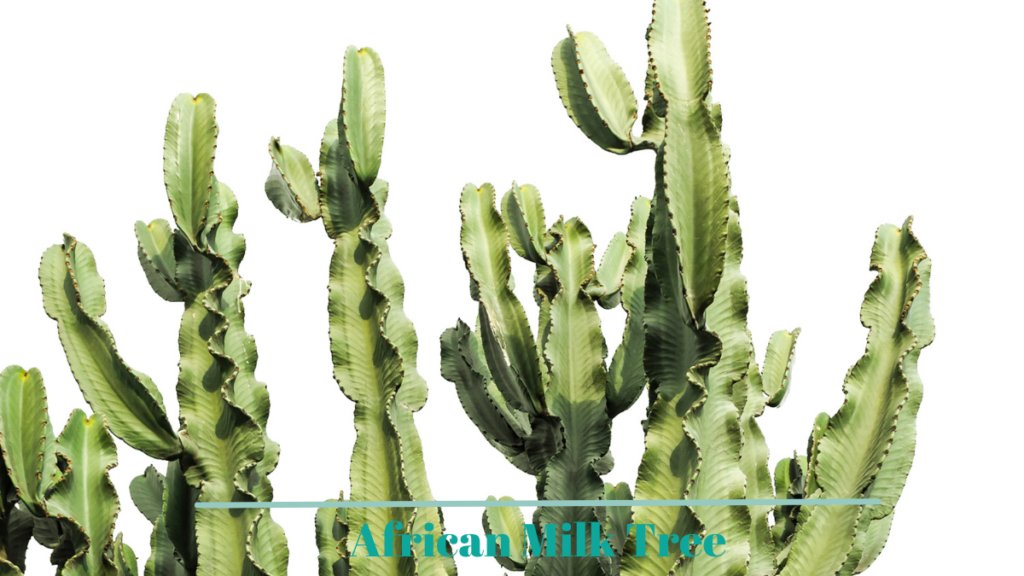African Milk Tree (Euphorbia trigona) is an attractive cactus-looking plant. It is a succulent that looks like a large cactus but with the advantage of having fewer spines than most cacti. Since your African Milk Tree is a succulent plant, it can tolerate dry conditions. Do know that the African Milk Tree is toxic to humans and pets, keep it away from children and pets. Here is a beginner’s guide on how to care for your African Milk Tree.

African Milk Tree Houseplant Care at a Glance
| Name | African Milk Tree |
| Scientific Name | Euphorbia trigona |
| Light | Bright Indirect Light. Can Tolerate Medium Light. |
| Daytime Temperature | 70 to 80 F (21-26C) |
| Night Time Temperature | 60 to 70 F (15-21C) |
| Water | Low Water |
| Humidity | Can Tolerate Dry Indoor Air |
| Potting | Well-draining, organic, cactus potting mix |
| Fertilizer | Once every month at half strength during its growing season ( Spring and Summer). Don’t fertilize in the Fall and Winter. |
| Toxic to Pets and Humans | Toxic |
African Milk Tree: Common Names
African Milk Tree is also called friendship cactus, candelabra cactus, cathedral cactus, and good luck cactus.
African Milk Tree: Varieties
Popular African Milk Tree varieties are Euphorbia trigona ‘Rubra’ and Euphorbia trigona ‘Royal Red’.
African Milk Tree: Size
African Milk Tree is a large succulent that can grow up to 6-9 feet tall outdoors. But it will usually be smaller when grown indoors. African Milk Tree is a fast-growing houseplant.
African Milk Tree: Toxic to Pets?
African Milk Trees are toxic to pets and humans. The milky latex sap is toxic and can irritate the skin and eyes of pets and humans. Keep it away from your pets and children. If you suspect ingestion of your African Milk Tree, call poison control immediately. Also, contact your Vet or Pediatrician immediately.
Light
African Milk Tree: Sun or Shade?
African Milk Trees will grow best in a bright indirect light location. Your African Milk Tree is a sun-loving plant and it can tolerate partial direct sun. It will happily grow in a south-facing or west-facing window.
Water
How Often Should You Water Your African Milk Tree?
Your African Milk Tree is a succulent plant and has low water requirements. Let the soil dry out halfway down the pot before watering.
How Do You Know When to Water Your African Milk Tree?
Water your African Milk Tree when the soil feels dry. The best way to tell when it’s time to water is by sticking your finger into the soil. Stick your finger in the soil 2 inches deep. If the soil feels dry, it’s time to water your African Milk Tree. If in doubt, it’s best not to water your African Milk Tree. Your African Milk Tree will do better in dry conditions than in soggy soil.
How Do You Make Sure There is Proper Drainage for Your African Milk Tree?
Your African Milk Tree Good drainage is important, you don’t want your African Milk Tree to sit in soggy soil. Make sure there are drainage holes at the bottom of the pot. After watering your African Milk Tree and you see water draining out of the pot’s drainage holes, make sure you empty out the accumulated water in the saucer. Don’t let your African Milk Tree’s pot sit in this puddle of water. It will cause root rot!
Do You Need to Mist Your African Milk Tree?
Your African Milk Tree is a houseplant that can tolerate dry indoor air. It is a succulent plant so it does not need additional moisture on top of its regular watering.

Soil
What Type of Potting Mix is Best for Your African Milk Tree?
Your African Milk Tree needs a well-draining, organic cactus potting mix.
How Do You Know When To Repot Your African Milk Tree?
Repot your African Milk Tree once every 2 years. Repot your African Milk Tree in a container with a diameter 2 inches larger than the current pot. Use cactus soil when repotting.
Fertilizer
Do You Need to Fertilize Your African Milk Tree?
Your African Milk Tree should be fertilized once every month in the Spring and Summer at half strength. Don’t fertilize in the Fall and Winter.
What Fertilizer Should You Use on Your African Milk Tree?
Use cactus food to fertilize your African Milk Tree.
Propagation
How Do You Propagate Your African Milk Tree?
Your African Milk Tree African Milk Tree Plant is easy to propagate. You can propagate the African Milk Tree plant by stem cutting. Below are steps on how to propagate the African Milk Tree Plant by stem cutting:
1. Take a Stem Cutting of African Milk Tree Plant
Pick a stem or arm near the base of your African Milk Tree plant. Cut the arm.
2. Let Your African Milk Tree Stem Dry
Place your African Milk Tree stem (arm) on a paper towel and let it dry for 5-7 days.
3. Plant Stem Cutting in New Pot
Plant the dry stem cutting of your African Milk Tree in a new pot. Use cactus potting mix. Allow it to grow roots. It will take 2 months to grow roots. You can check by gently tugging on your African Milk Tree cutting, if there is resistance, that means it has grown roots. You can transplant your African Milk Tree to its permanent pot afterward.
4. Place New African Milk Tree Plant in a Spot with a Warm Location with Bright Indirect Sun
Place your new African Milk Tree plant in a warm spot with bright indirect sunlight.
Common Problems of African Milk Tree Care
The most common problems that affect African Milk Tree are mealy bugs, root rot, and yellowing leaves.
African Milk Tree Problem: Fluffy White Growth In Between the Leaves and Stems of your African Milk Tree
Problem: There are fluffy white growths in between the leaves and stems of your African Milk Tree.
Cause: Mealybugs are causing the fluffy white growth on your African Milk Tree. It is a common houseplant disease.
Solution: To get rid of mealybugs on your African Milk Tree, wash your plant with water. You can also use soapy water. Spraying rubbing alcohol on affected areas can also get rid of mealybugs. Horticultural oil and insecticidal soap are also effective in getting rid of mealybugs.
Check out our article on how to make your own homemade pesticides using baby shampoo: How to Make Horticultural Oil and How to Make Insecticidal Soap
African Milk Tree Problem: Looks Wilted (Soil is Wet)
Problem: Your African Milk Tree looks wilted even if the soil is wet. Check for root rot by pulling the plant out and examining the roots. If the roots of your African Milk Tree plant look mushy (healthy roots are firm) and the roots are gray to black in color, these are telltale signs of root rot.
Cause: Root rot is caused by fungus and is a serious problem for your African Milk Tree. Root rot is a result of wet soil due to overwatering or poor drainage.
Solution: When your African Milk Tree is afflicted with root rot the chance of survival is slim. Your best course of action is to throw your African Milk Tree out and start over with a new plant. This time don’t overwater your African Milk Tree and make sure there is good drainage in the pot.
African Milk Tree Problem: Yellowing leaves
Problem: If you see yellowing leaves on your African Milk Tree or your African Milk Tree leaves are falling off, that is a sign that something is wrong.
Cause: If you see yellowing leaves it can be a result of overwatering or underwatering. Yellow leaves can also be a result of cold temperatures.
Solution: Check to see if your African Milk Tree is being overwatered or underwatered. Also, check the temperature. Is the room too cold for your African Milk Tree? If so, move your African Milk Tree to a warmer spot and adjust your watering.
You May Also Be Interested In:
How to Take Care of Haworthia (infograph)

